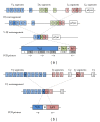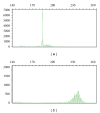The role of molecular pathology in the diagnosis of cutaneous lymphomas
- PMID: 23213624
- PMCID: PMC3506916
- DOI: 10.1155/2012/913523
The role of molecular pathology in the diagnosis of cutaneous lymphomas
Abstract
Primary cutaneous lymphomas can be difficult to be distinguished from reactive mimics, even when integrating histologic, immunophenotypic, and clinical findings. Molecular studies, especially PCR-based antigen receptor gene rearrangement (ARGR) analysis, are frequently useful ancillary studies in the evaluation of cutaneous lymphoproliferations. The biologic basis of ARGR studies is discussed, as well as a comparison of various current protocols. The pitfalls and limitations of ARGR analysis are also highlighted. Recent advances in the understanding of the molecular pathogenesis of various cutaneous lymphomas are discussed. Some of these nascent discoveries may lead to the development of diagnostically useful molecular assays.
Figures



Similar articles
-
Molecular immunoglobulin/T- cell receptor clonality analysis in cutaneous lymphoproliferations. Experience with the BIOMED-2 standardized polymerase chain reaction protocol.Haematologica. 2003 Jun;88(6):659-70. Haematologica. 2003. PMID: 12801842
-
T-cell receptor antibodies expression in benign and malignant cutaneous lymphoid infiltrates in comparison with T-cell receptor gene rearrangement and its diagnostic utility in borderline cases.Pathol Res Pract. 2020 Dec;216(12):153279. doi: 10.1016/j.prp.2020.153279. Epub 2020 Nov 4. Pathol Res Pract. 2020. PMID: 33186884
-
Cutaneous lymphomas: an update. Part 2: B-cell lymphomas and related conditions.Am J Dermatopathol. 2014 Mar;36(3):197-208; quiz 209-10. doi: 10.1097/DAD.0b013e318289b20e. Am J Dermatopathol. 2014. PMID: 24658377 Review.
-
Polymerase chain reaction-based clonality testing in tissue samples with reactive lymphoproliferations: usefulness and pitfalls. A report of the BIOMED-2 Concerted Action BMH4-CT98-3936.Leukemia. 2007 Feb;21(2):222-9. doi: 10.1038/sj.leu.2404482. Epub 2006 Dec 14. Leukemia. 2007. PMID: 17170729
-
Immunophenotypic and antigen receptor gene rearrangement analysis in T cell neoplasia.Am J Pathol. 1989 Apr;134(4):761-85. Am J Pathol. 1989. PMID: 2495724 Free PMC article. Review.
Cited by
-
Secondary syphilis mimicking marginal zone B-cell lymphoma.JAAD Case Rep. 2021 Dec 15;20:50-53. doi: 10.1016/j.jdcr.2021.11.026. eCollection 2022 Feb. JAAD Case Rep. 2021. PMID: 35059487 Free PMC article. No abstract available.
-
Genomic imbalances and microRNA transcriptional profiles in patients with mycosis fungoides.Tumour Biol. 2016 Oct;37(10):13637-13647. doi: 10.1007/s13277-016-5259-8. Epub 2016 Jul 29. Tumour Biol. 2016. PMID: 27473081
-
An Update on Molecular Biology of Cutaneous T Cell Lymphoma.Front Oncol. 2020 Jan 22;9:1558. doi: 10.3389/fonc.2019.01558. eCollection 2019. Front Oncol. 2020. PMID: 32039026 Free PMC article. Review.
References
-
- Swerdlow SH, Campo E, Harris NL, et al., editors. WHO Classification of Tumours of Haematopoietic and Lymphoid Tissue. 4th edition 2008.
-
- Olsen, Vonderheid E, Pimpinelli N, et al. Revisions to the staging and classification of mycosis fungoides and Sezary syndrome: a proposal of the International Society for Cutaneous Lymphomas (ISCL) and the cutaneous lymphoma task force of the European Organization of Research and Treatment of Cancer (EORTC) Blood. 2007;110(6):1713–1722. - PubMed
-
- Pimpinelli N, Oslen E, Santucci E, et al. Defining early mycosis fungoides. Journal of the American Academy of Dermatology. 2005;53(6):1053–1063. - PubMed
-
- van Dongen JJM, Wolvers-Tettero ILM. Analysis of immunoglobulin and T cell receptor genes. Part I: basic and technical aspects. Clinica Chimica Acta. 1991;198(1-2):1–91. - PubMed
LinkOut - more resources
Full Text Sources

